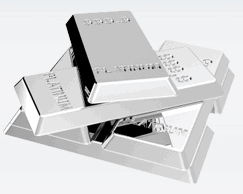Platinum Education
 Platinum gets its name from the Latin word ‘platina’, which means ‘silver’.
The gorgeous, natural white luster of platinum and its rare occurrence in nature
has made it a metal more coveted than gold even.
Platinum gets its name from the Latin word ‘platina’, which means ‘silver’.
The gorgeous, natural white luster of platinum and its rare occurrence in nature
has made it a metal more coveted than gold even.
History Of Platinum
Platinum was officially discovered in 1735 by Ulloa during an expedition in
Peru. However, it has been known to be used by pre-Columbian Native
Americans. In fact the Spaniards thought platinum to be an undesirable element in
their quest for silver and more often than not, discarded it. The metal really
gained popular acceptance only when it was used to make the frame of the Crown of
Queen Elizabeth for her Coronation.
Attributes Of Platinum
Platinum is an extremely dense metal and much harder than gold.
This makes it perfect for manufacturing jewelry since it does not have to be mixed
with other metals to make it more durable. Additionally, since platinum is naturally
white it does not wear away to a dull yellow color over time like white
gold can. Platinum is also extremely resistant to wear and tear and does not
rust or corrode. It scratches less easily than gold.
Since Platinum is far more rare than gold it is also far more costly.
In fact, Platinum can cost you almost twice the cost of pure gold and even more
than twice the cost of 14K gold. Of course, platinum is also more pure than 18K
or 14K gold. Platinum contains 95% pure platinum while 18K gold contains only 75%
pure gold and 14K gold contains only 58% pure gold.
Understanding Platinum Terms
Platinum jewelry can contain different quantities of platinum.
Jewelry that contains at least 950 parts per thousand of platinum is classified
as pure platinum jewelry. It is marked as ‘Platinum’.
Jewelry that contains 950, 900 or 850 parts per thousand of platinum
cannot be marked as ‘Platinum’. It is marked as ‘Pt’ or ‘Plat’
with the number to indicate its purity. Example: “850 Plat” or “900 Pt”.
One thing to beware of is that many jewelers mark jewelry that contains 950 parts
per thousand of platinum and platinum group metals with a minimum of 500 parts of
pure platinum. Platinum group metals include Platinum, Iridium, Palladium, Rhodium,
Ruthenium and Osmium. The marking generally reads ‘Platinum’ with a further description
of the exact mix of metals. This is however, not to be confused with pure 950+ Platinum.
Caring For Your Platinum Jewelry
Here are some quick tips on caring for your platinum jewelry.
- Use a jewelry box to store your platinum jewelry. Ensure that the
box is lined with velvet or has separate compartments for separate pieces. The pieces
can bump into each other and scratch the surface.
- If you are engaging in hardy physical activity take off your platinum jewelry.
- Wash and clean platinum jewelry in mild soapy water using a soft brush.
- If you own platinum and diamond jewelry, check the settings of your diamonds
regularly. A loosened prong can result in the diamond falling off. You
need to get this corrected immediately. However, since platinum is a hard metal
it provides for a very secure setting for diamonds.
Thus, platinum is far more rare and precious than gold. However, while it is highly
coveted the cost can be a hindrance to many buyers.